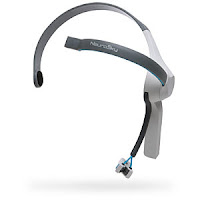So, I ordered a Neurosky Mindwave from ThinkGeek.com and it arrived in the mail a few weeks back.
It's been sitting on my desk waiting to be hacked.
What is a Mindwave, you ask? It's a brain scanner. You put it on your head, sync it up to your computer and software will begin to respond to your state of mind.
That doesn't mean that it will read your thoughts. You can't dictate to the computer from inside your head or play advanced video games without a controller. However, you can monitor and trigger responses based on your level of attention and meditation and eye blinks.
These three items let you do all kinds of interesting things.
The software that's included has a meditation journal, a display of fireworks that explode when you blink, a game where an and will roll a rock faster or slower depending on how hard you concentrate and a number of other applications.
So, what's the plan?
Well, I would like to confirm that I can actually read these values in real time from my computer. Once I've done that, I will record those values to analyze later.
From there...I'm not too sure.
I'd like to try to integrate it with a microcontroller system like an Arduino. If I can do that, then I can make things happen in the real world based on how hard I concentrate or relax.
Over the coming weeks, I will post the results of my experiments here.
